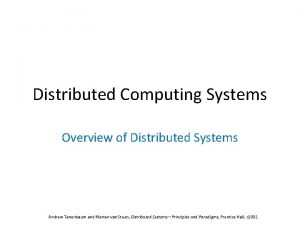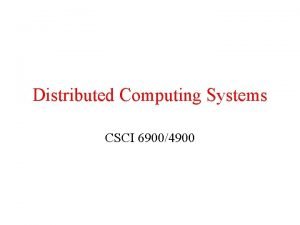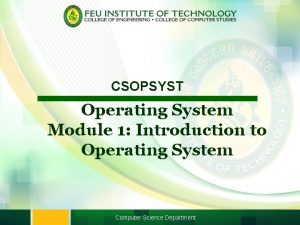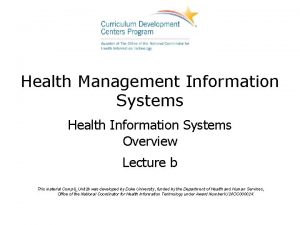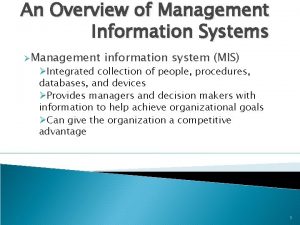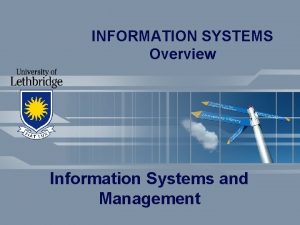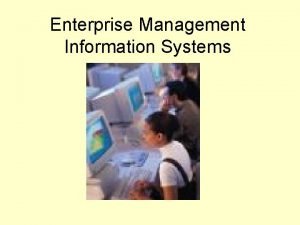Health Management Information Systems Health Information Systems Overview













- Slides: 13

Health Management Information Systems Health Information Systems Overview Lecture b This material (Comp 6 Unit 2) was developed by Duke University, funded by the Department of Health and Human Services, Office of the National Coordinator for Health Information Technology under Award Number IU 24 OC 000024. This material was updated by Normandale Community College, funded under Award Number 90 WT 0003. This work is licensed under the Creative Commons Attribution-Non. Commercial-Share. Alike 4. 0 International License. To view a copy of this license, visit http: //creativecommons. org/licenses/by-nc-sa/4. 0/

Health Information Systems Overview Learning Objectives • Examine the challenges presented by emerging trends in information technology, social media, and global communications; and • Discuss the advantages and disadvantages of using the Internet as a platform for health care applications. 2

Impact of Emerging Technologies • Convergence of media and emergence of the Internet results in a networked communication infrastructure • Facilitates access to health information and health-related support services • Expands the communication choices for health professionals, patients, and consumers 3

IT Trends • • • Tele-technology IT Security Interoperability Mobile technology Social media Cloud-based technology 4

Social Media • • • Social networks Blogs Forums Wikis Photo video Podcasts 5

Cloud-Based Technology • Computing where data and services are delivered via the Internet – Systems typically not maintained and stored at the place of use – Example: Google Docs and other document storage sites. 6

Challenges Presented • Concerns with privacy and security • Risk of liability • Lack of law or legislation governing the boundaries • Lack of payment for engagement • Lack of frequent data updates • Resistance by health care providers 7

Impact of the Internet • • Increase in informed consumers Availability of online PHRs New forms of communication Accessibility of health care products for purchasing 8

Internet Advantages • • • Cost effective Faster deployment Little or no IT support needed Designed for sharing Better technology for mobile computing 9

Internet Disadvantages • Privacy – The right of a patient to control disclosure of protected health information • Security – Access control and protection • Scalability – System growth with user/data growth 10

Health Information Systems Overview Summary • Definition of an information system and its characteristics • Types of information systems that support the health care enterprise requirements • Types of technologies that support health care information systems • Challenges of emerging trends • Advantages and disadvantages of using the Internet 11

Health Information Systems Overview References – Lecture b References American Medical Informatics Association (AMIA). (2013). Glossary or acronyms and terms commonly used in informatics. Retrieved from https: //www. amia. org/glossary Centers for Disease Control and Prevention. (2011, May). Social media at CDC. Retrieved from http: //www. cdc. gov/Social. Media/Tools/ CDC and the National Cancer Institute. (2011, May). Health communication basics. Retrieved from http: //www. cdc. gov/healthcommunication/Health. Basics/What. Is. HC. html Daniel, H. , & Snyder Sulmasy, L. (2015). American College of Physicians: Policy Recommendations to Guide the Use of Telemedicine in Primary Care Settings: AN American College of Physicians Position Paper. Retrieved from http: //annals. org/article. aspx? articleid=2434625 Mell, P. , & Grance, T. (2009, October). The NIST definition of cloud computing. Retrieved from http: //www. nist. gov/itl/cloud/upload/cloud-def-v 15. pdf Kaplan, A. M. & Haenlein, M. (2010). Users of the world unite! The challenges and opportunities of social media. Business Horizons 53(1), 59 -68. U. S. Department of Health and Human Services. (2000). Healthy people 2010: Objectives for improving health. Retrieved from http: //www. healthypeople. gov/2010/Document/tableofcontents. htm#volume 1 U. S. Department of Health and Human Services. (2006, June). Expanding the reach and impact of consumer e-Health tools. Retrieved from http: //www. health. gov/communication/ehealthtools/pdf/ehealthreport. pdf 12

Health Information Systems Overview Lecture b This material was developed by Duke University, funded by the Department of Health and Human Services, Office of the National Coordinator for Health Information Technology under Award Number IU 24 OC 000024. This material was updated by Normandale Community College, funded under Award Number 90 WT 0003. 13
 Distributed systems
Distributed systems Sap ps
Sap ps Distributed systems overview
Distributed systems overview Overview of operating systems
Overview of operating systems Operating systems overview
Operating systems overview Overview of education in health care
Overview of education in health care Content management system capabilities
Content management system capabilities Intro to human resource management
Intro to human resource management Management topics for project
Management topics for project Gym management system documentation software
Gym management system documentation software The forrester wavetm real-time interaction management
The forrester wavetm real-time interaction management Management overview
Management overview Peta konsep manajemen ekonomi
Peta konsep manajemen ekonomi Overview of financial management
Overview of financial management
